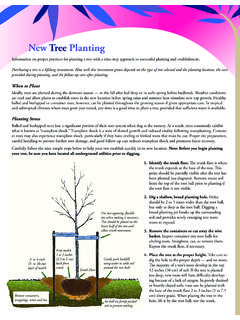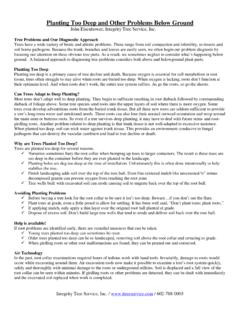Transcription of KCMO Parks and Recreation Department --Forestry …
1 KCMO Parks and Recreation Department -- forestry operations Street tree planting Requirements A. PERMISSION TO PLANT: No tree may be planted on City right-of-way or City owned property without written permission from the City Forester's office. 1. Developers are required to submit TWO copies of a street tree planting design that includes the following information. a. tree species and size identified. b. Location/placement of trees on map of proposed plat. c. Location of proposed or existing utilities, including streetlights. d.
2 Easement width between sidewalk and curb. In the case of no sidewalks, then include the width of the easement outside of the curb or road. e. Width of tree planting area. Generally, this is the space between the curb and sidewalk, or the curb and back of City right-of-way. Actual width must be specified on plat. f. Approximate date when street trees will be planted (if known). g. This document is required to be on the planting plan. ALL PLANS SUBMITTED WITHOUT THE ABOVE COMPONENTS WILL BE. REJECTED. 2. tree planting permits are available upon inspection by the City Forester's office.
3 3. A plat approved by the City Forester's office serves as a permit for developers. B. tree LOCATIONS: Determine planting locations using the following guidelines: 1. Space 30 - 60 feet apart. Within this range, space narrow canopied trees closer together and wider canopied trees farther apart. Closer spacing is allowed in some landscaping situations, such as office or business planting with certain tree species. 2. Place trees not closer than 50 feet from an approach corner with a traffic signal or sign. 3. Place trees not closer than 40 feet from an approach corner without a traffic signal or sign.
4 4. Place trees not closer than 30 feet from a non-approach corner. 5. Place trees not closer than 15 feet from a street light. 6. Place trees not closer than 8 feet from a driveway. 7. Place trees not closer than 5 feet from a fire hydrant. 8. Place trees not closer than 5 feet from a storm box, gas valve, water valve, cable box, or any other above ground utility. forestry Section, Street tree planting Requirements January 2014 page 1. 9. Do not place trees with an average height of more than 40 feet under overhead wires. 10.
5 Do not place trees in a bus stop zone where passengers enter and exit bus. C. tree SIZE: Plant only trees with a caliper size of at least 2 inches. D. APPROVED TREES: Plant preferred trees from the current planting list (FIGURE 1: attached) provided by the City Forester's office. Alternatives are acceptable, but must be approved by the City Forester's office. E. SPECIES DIVERSITY: Species diversity is an important component of a sustainable urban forest. We require developers to plant a diverse range of trees in accordance with the following: 1.
6 If less than 50 trees, then not more than 50% may be of a single genus. 2. If 50-100 trees, then not more than 50% of a single genus, and not more than 30%. of a single species. 3. If over 100 trees, then not more than 30% of a single genus, and not more than 20% of a single species. F. SIZE OF tree & WIDTH OF RIGHT-OF-WAY: Trees planted in public right-of-way must have adequate clearance from the curb and sidewalk within that This ensures the healthy growth of the tree , as well as preserving the integrity of the surrounding infrastructure.
7 When choosing a tree species, reference its maximum dbh. As a general rule, use the following five size classifications. For more specific planting widths regarding specific tree species, reference FIGURE 1. 1. If is less than 5' in width DO NOT plant. 2. If is between 5' and 6' in width, plant tree species with a maximum dbh of 24 . 3. If is between 6' and 8' in width, plant tree species with a maximum dbh of 42 . 4. If is between 8' and 9' in width, plant tree species with a maximum dbh of 50 . 5. If is greater than 9 in width, plant any tree species on the recommended tree list.
8 forestry Section, Street tree planting Requirements January 2014 page 2. G. tree planting SPECIFICATIONS (FIGURES 1- 4). 1. The representative from the City Forester's office may inspect any phase of this operation and may reject any plant material improperly handled during any phase of this operation. Nothing in this Section shall be interpreted as relieving the developer of the responsibility of providing healthy, viable plants, nor shall it have any effect upon the terms of the warranty specified. 2. Protection of Existing Plants: Do not store materials or equipment, or operate equipment under branches of any existing trees, except as actually required for planting in those areas.
9 If existing plants are damaged during planting , Developer shall replace such plants with the same species and size as those damaged at no cost to Parks and Recreation . Determination of the extent of damage and value of damaged plant shall rest solely with the representative of the City Forester. (See FIGURE 5 for tree protection guidelines). 3. All trees shall be 2 minimum caliper, smaller calipers require prior approval from the City Forester. 4. All plants shall be symmetrical in growth with balanced root and top growth and shall be No.
10 1 in grade or type, conforming to the latest edition of American Standard of Nursery Stock , ANSI (2004) referenced herein. Trees shall have a single straight trunk, single dominant central leader (when characteristic of the species), and a well-balanced branch structure. 5. During transportation of plant material, care will be taken to prevent injury or drying out of the trees. Trees will be rejected if the roots are dried out or if the tree has been damaged during transit. Plants must be protected at all times from sun or drying winds.






